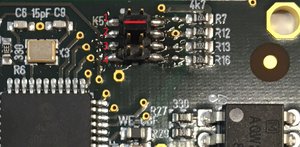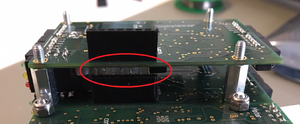Additional DIO-Boards of the DCi Control Electronics
The DCi Robot is shipped with one DIO module as standard. Should you require additional digital inputs and outputs, two additional DIO modules can be added. The hardware installation is simple, however, you need to get access to the underside of the robot.
Hardware installation
If there is only the standard DIO module installed, bridge the second pin-set of header K5 as shown in figure 1 using the jumper supplied with the module. (If there are already two DIO modules installed, bridge pin-pair 3 of K5.)
- Bring the robot into the referencing position, so that you can later turn it on its side.
- Turn off the robot and disconnect from power source.
- Turn the robot on its side. Once flipped one its side. You will see the electronics modules installed in the robot.
- Remove the four M3 hex nuts from one of the exposed modules and connect the four stand-off hex spacers supplied with the new DIO module.
- Now carefully insert the module while making sure that the bus connector lines up and all pins get inserted into their socket counterparts (figure 2).
- Fix the module using the existing M3 lock nuts.
Software configuration
If you were to switch on the robot after the hardware installation, you would notice that the green LED of the newly installed DIO module is not flashing. That means that The software is currently not communicating with that module.
To fix that, you need to get FTP or Putty access to the embedded linux board. FTP access is described in Section 1 and 2 of the document available here: FTP_and_putty_Access
- Edit the file
\home\root\TinyCtrl\Data\Projects\EmbeddedCtrl.prj - In that file, find the entry
<DIOModule ID="112"/> - Right behind that entry, enter
, to activate the second DIO module<DIOModule ID="144"/>, to activate the third DIO module
- If you have two DIO modules installed in total, you file should look similar to this
... <DIOModule ID="112"/> <DIOModule ID="128"/> ...
- If you have two DIO modules installed, you file should look similar to this
... <DIOModule ID="112"/> <DIOModule ID="128"/> <DIOModule ID="144"/> ...

